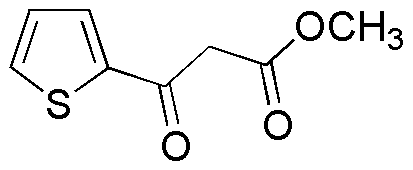Methyl 3-oxo-3-(thiophen-2-yl)propanoate is widely utilized in research focused on:
- Pharmaceutical Development: This compound serves as a key intermediate in the synthesis of various pharmaceuticals, particularly those targeting metabolic disorders, due to its unique structural properties that enhance biological activity.
- Agrochemical Formulations: It is used in the formulation of agrochemicals, offering improved efficacy in pest control products, which can lead to higher crop yields and reduced environmental impact.
- Material Science: The compound is explored in creating novel materials, such as polymers and coatings, that exhibit enhanced thermal and mechanical properties, making them suitable for advanced applications in electronics and automotive industries.
- Organic Synthesis: Methyl 3-oxo-3-(thiophen-2-yl)propanoate is a valuable building block in organic synthesis, enabling chemists to construct complex molecules more efficiently compared to traditional methods.
- Research in Biochemistry: It is utilized in biochemical research to study enzyme interactions and metabolic pathways, providing insights that can lead to the development of new therapeutic strategies.
General Information
Properties
Safety and Regulations
Applications
Methyl 3-oxo-3-(thiophen-2-yl)propanoate is widely utilized in research focused on:
- Pharmaceutical Development: This compound serves as a key intermediate in the synthesis of various pharmaceuticals, particularly those targeting metabolic disorders, due to its unique structural properties that enhance biological activity.
- Agrochemical Formulations: It is used in the formulation of agrochemicals, offering improved efficacy in pest control products, which can lead to higher crop yields and reduced environmental impact.
- Material Science: The compound is explored in creating novel materials, such as polymers and coatings, that exhibit enhanced thermal and mechanical properties, making them suitable for advanced applications in electronics and automotive industries.
- Organic Synthesis: Methyl 3-oxo-3-(thiophen-2-yl)propanoate is a valuable building block in organic synthesis, enabling chemists to construct complex molecules more efficiently compared to traditional methods.
- Research in Biochemistry: It is utilized in biochemical research to study enzyme interactions and metabolic pathways, providing insights that can lead to the development of new therapeutic strategies.
Documents
Safety Data Sheets (SDS)
The SDS provides comprehensive safety information on handling, storage, and disposal of the product.
Product Specification (PS)
The PS provides a comprehensive breakdown of the product’s properties, including chemical composition, physical state, purity, and storage requirements. It also details acceptable quality ranges and the product's intended applications.
Certificates of Analysis (COA)
Search for Certificates of Analysis (COA) by entering the products Lot Number. Lot and Batch Numbers can be found on a product’s label following the words ‘Lot’ or ‘Batch’.
*Catalog Number
*Lot Number
Certificates Of Origin (COO)
This COO confirms the country where the product was manufactured, and also details the materials and components used in it and whether it is derived from natural, synthetic, or other specific sources. This certificate may be required for customs, trade, and regulatory compliance.
*Catalog Number
*Lot Number
Safety Data Sheets (SDS)
The SDS provides comprehensive safety information on handling, storage, and disposal of the product.
DownloadProduct Specification (PS)
The PS provides a comprehensive breakdown of the product’s properties, including chemical composition, physical state, purity, and storage requirements. It also details acceptable quality ranges and the product's intended applications.
DownloadCertificates of Analysis (COA)
Search for Certificates of Analysis (COA) by entering the products Lot Number. Lot and Batch Numbers can be found on a product’s label following the words ‘Lot’ or ‘Batch’.
*Catalog Number
*Lot Number
Certificates Of Origin (COO)
This COO confirms the country where the product was manufactured, and also details the materials and components used in it and whether it is derived from natural, synthetic, or other specific sources. This certificate may be required for customs, trade, and regulatory compliance.

